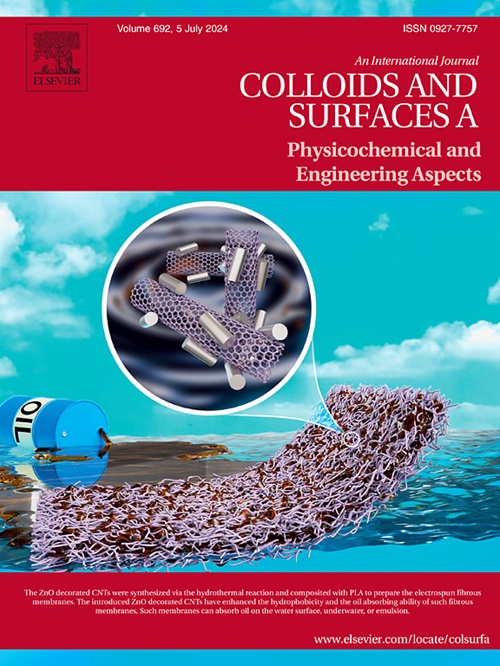In situ synthesis of Bi/Bi24O31Br10 nanosheet for enhanced photocatalytic degradation of tetracycline: Kinetics, density functional theory, and toxicity studies
IF 4.9
2区 化学
Q2 CHEMISTRY, PHYSICAL
Colloids and Surfaces A: Physicochemical and Engineering Aspects
Pub Date : 2025-04-28
DOI:10.1016/j.colsurfa.2025.137074
引用次数: 0
Abstract
Achieving highly controlled and directional electron transfer at catalyst interface remains a persistent challenge in photocatalysis. Herein, Bi/Bi24O31Br10 nanosheets were prepared through a simple in situ reduction method to enhance the photocatalytic degradation of tetracycline (TC). Leveraging the surface plasmon resonance (SPR) effect of metallic Bi and the marked enhancement of interfacial charge transfer and separation efficiency, the optimized Bi/Bi24O31Br10 nanosheets exhibited significantly improved TC photodegradation performance, achieving a degradation efficiency of 80.78 % within 120 min under visible light irradiation-surpassing the performance of pristine Bi24O31Br10 nanosheets. Notably, the Bi/Bi24O31Br10 nanosheets demonstrated robust degradation efficiency under diverse conditions, including a broad pH range (3.0–9.0), varying TC concentrations (5–25 mg L−1), different photocatalyst dosages (5–20 mg), and in the presence of common inorganic anions (e.g., Cl-, HCO3-, SO42-, and NO3-). The mineralization process and degradation pathway of TC were elucidated through active sites trapping experiments, liquid chromatography-mass spectrometry (LC-MS), three-dimensional excitation-emission matrix (3D EEM) spectroscopy, and density functional theory (DFT) calculations. Additionally, the ecotoxicity of TC and its degradation intermediates was evaluated using the Toxicity Estimation Software Tool (T.E.S.T.) and the Ecological Structure Activity Relationships (ECOSAR) model, revealing a reduction in environmental toxicity during the degradation process. This study provides valuable insights into the rational design of advanced Bi-based semiconductor photocatalysts for efficient environmental remediation.
用于增强四环素光催化降解的Bi/Bi24O31Br10纳米片的原位合成:动力学、密度泛函数理论和毒性研究
在催化剂界面上实现高度可控和定向的电子转移一直是光催化领域的挑战。本文通过原位还原法制备了Bi/Bi24O31Br10纳米片,以增强四环素(TC)的光催化降解能力。利用金属Bi的表面等离子体共振(SPR)效应和界面电荷转移和分离效率的显著增强,优化后的Bi/Bi24O31Br10纳米片的TC光降解性能显著提高,在可见光照射下,120 min内的降解效率达到80.78 %,超过了原始Bi24O31Br10纳米片的性能。值得注意的是,Bi/Bi24O31Br10纳米片在多种条件下表现出强大的降解效率,包括广泛的pH范围(3.0-9.0),不同的TC浓度(5-25 mg L−1),不同的光催化剂剂量(5-20 mg),以及常见的无机阴离子(如Cl-, HCO3-, SO42-和NO3-)存在。通过活性位点捕获实验、液相色谱-质谱(LC-MS)、三维激发-发射矩阵(3D EEM)光谱和密度泛函理论(DFT)计算,阐明了TC的矿化过程和降解途径。此外,利用毒性估计软件工具(T.E.S.T.)和生态结构活性关系(ECOSAR)模型对TC及其降解中间体的生态毒性进行了评估,揭示了降解过程中环境毒性的降低。该研究为合理设计先进的铋基半导体光催化剂以实现高效的环境修复提供了有价值的见解。
本文章由计算机程序翻译,如有差异,请以英文原文为准。
求助全文
约1分钟内获得全文
求助全文
来源期刊
CiteScore
8.70
自引率
9.60%
发文量
2421
审稿时长
56 days
期刊介绍:
Colloids and Surfaces A: Physicochemical and Engineering Aspects is an international journal devoted to the science underlying applications of colloids and interfacial phenomena.
The journal aims at publishing high quality research papers featuring new materials or new insights into the role of colloid and interface science in (for example) food, energy, minerals processing, pharmaceuticals or the environment.

 求助内容:
求助内容: 应助结果提醒方式:
应助结果提醒方式:


